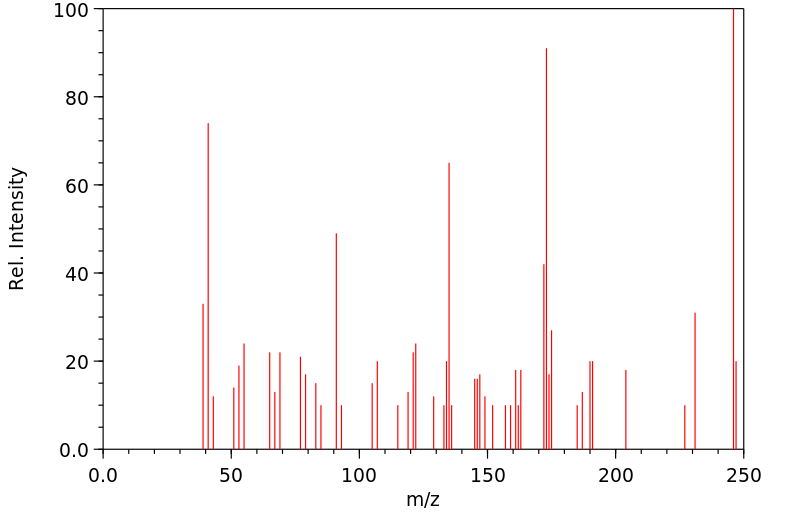(3R)-3ab,5,5a,9ba-四氢-3,5aa,9-三甲基萘并[1,2-b]呋喃-2,8(3H,4H)-二酮 | 481-07-2
中文名称
(3R)-3ab,5,5a,9ba-四氢-3,5aa,9-三甲基萘并[1,2-b]呋喃-2,8(3H,4H)-二酮
中文别名
——
英文名称
(+/-)-β-Santonin
英文别名
beta-Santonin;(3R,3aS,5aS,9bS)-3,5a,9-trimethyl-3a,4,5,9b-tetrahydro-3H-benzo[g][1]benzofuran-2,8-dione
CAS
481-07-2
化学式
C15H18O3
mdl
——
分子量
246.306
InChiKey
XJHDMGJURBVLLE-OMSPQPPYSA-N
BEILSTEIN
——
EINECS
——
-
物化性质
-
计算性质
-
ADMET
-
安全信息
-
SDS
-
制备方法与用途
-
上下游信息
-
文献信息
-
表征谱图
-
同类化合物
-
相关功能分类
-
相关结构分类
计算性质
-
辛醇/水分配系数(LogP):2.3
-
重原子数:18
-
可旋转键数:0
-
环数:3.0
-
sp3杂化的碳原子比例:0.6
-
拓扑面积:43.4
-
氢给体数:0
-
氢受体数:3
SDS
上下游信息
反应信息
-
作为反应物:描述:(3R)-3ab,5,5a,9ba-四氢-3,5aa,9-三甲基萘并[1,2-b]呋喃-2,8(3H,4H)-二酮 在 potassium carbonate 、 xylene 作用下, 生成 山道年参考文献:名称:桑托宁的化学。第一部分。桑顿素的一些重排产物摘要:DOI:10.1039/jr9550004430
-
作为产物:参考文献:名称:Artegallin,一种来自 Artemisia caerulescens subsp. 的倍半萜内酯。加利卡摘要:摘要 从 Artemisia caerulescens subsp. 中分离出 4 种eudesmanolides。加利卡。新的eudesmanolide artegallin的组成和立体化学是根据其光谱特性和转化为β-santonin来确定的。DOI:10.1016/s0031-9422(00)81256-x
文献信息
-
Palladium‐Catalyzed Silacyclization of (Hetero)Arenes with a Tetrasilane Reagent through Twofold C−H Activation作者:Dingyi Wang、Mingjie Li、Xiangyang Chen、Minyan Wang、Yong Liang、Yue Zhao、Kendall N. Houk、Zhuangzhi ShiDOI:10.1002/anie.202015117日期:2021.3.22The use of an operationally convenient and stable silicon reagent (octamethyl‐1,4‐dioxacyclohexasilane, ODCS) for the selective silacyclization of (hetero)arenes via twofold C−H activation is reported. This method is compatible with N‐containing heteroarenes such as indoles and carbazoles of varying complexity. The ODCS reagent can also be utilized for silacyclization of other types of substrates,
-
[EN] STRIGOLACTONE FORMULATIONS AND USES THEREOF<br/>[FR] FORMULATIONS DE STRIGOLACTONE ET LEURS UTILISATIONS申请人:ASILOMAR BIO INC公开号:WO2015061764A1公开(公告)日:2015-04-30Disclosed herein plant propagation materials, methods of manufacturing, formulations and uses thereof. The plant propagation materials disclosed herein may comprise a strigolactone obtained by a biosynthetic process. The plant propagation material may comprise a chemical mimic of a strigolactone. The strigolactone may be 5-deoxystrigol. Methods of manufacturing the plant propagation materials may comprise a chemical process. Alternatively, methods of manufacturing the plant propagation material may comprise a biosynthetic process. The methods may comprise use of one or more polynucleotides. The polynucleotides may encode a metabolite. The polynucleotides may comprise one or more genes encoding one or more components of a strigolactone pathway.
-
The chemistry of santonin—V作者:Wesley Cocker、N.J.H. Dodds、T.B.H. McMurryDOI:10.1016/0040-4020(58)80007-1日期:1958.1Three tetrahydro-11β(H)-santonins have been obtained by the hydrogenation of 11β(H)-santonin over palladised charcoal. Two of these tetrahydro-11β(H)-santonins were previously obtained by Clemo. They have now been shown to have a trans-a/b ring-fusion, by relating them to the stable trans-a/b ring-fused tetrahydrosantonin. A third tetrahydro-11β(H)-santonin (cis-a/b ring-fusion) and 1:2-dihydro-11β(H)-santonin
-
The chemistry of santonin. Part VIII. Interconversion of the desmotroposantonins
-
Efficacy of Ipratropium Bromide Aqueous Nasal Spray in the Prevention of Nasal Secretion Induced by Inhaled Methacholine作者:A. Smeraldi、E. Crimi、M. Milanese、A. Rossetti、L. Cantini、V. BrusascoDOI:10.2165/00044011-200222040-00006日期:——Objective: The present study was conducted to assess if a new formulation of ipratropium bromide nasal spray could prevent the nasal hypersecretion induced by a whole nasal challenge with increasing doses of methacholine. Patients and methods: Twenty adult outpatients with ongoing hypersecretive rhinitis were selected and, after a preliminary session without any pretreatment, randomised to receive a single dose of nasal aqueous ipratropium bromide 80μg and matched placebo administered via a metered pump 60 minutes before methacholine challenge on two consecutive days. In each session, methacholine was inhaled into the nostrils at four increasing concentrations of 1, 4, 16 and 64 mg/ml, at 20-minute intervals. The induced secretion was evaluated by weighing a cotton tampon placed in each nostril for 30 seconds following the methacholine stimulation; weights were adjusted for spontaneous secretion. In addition, an acoustic rhinometer was used to measure the change in resistance and volume of each nasal cavity. Results: The nasal discharge (adjusted for pretreatment values) was significantly reduced after pretreatment with ipratropium bromide, both in the cumulative weight (p < 0.01) and at each methacholine concentration (p < 0.05 after 1 and 4 mg/ml, p < 0.01 after 16 and 64 mg/ml). No relevant changes in nasal patency were observed during the test without pretreatment, nor during the two treatment sessions; similarly, no significant differences were observed in the comparison between active drug and placebo for both resistance and volume. Conclusions: The results of the present study demonstrate that an intranasal aqueous solution of ipratropium bromide reduces the nasal discharge induced by locally applied methacholine. No effects were seen in the parameters used to measure nasal congestion.目的:本研究旨在评估异丙托溴铵鼻喷雾剂的新配方是否可以预防因乙酰甲胆碱剂量增加而引起的全鼻刺激引起的鼻分泌过多。患者和方法:选择了 20 名患有持续性高分泌性鼻炎的成年门诊患者,在没有任何预处理的初步治疗后,随机接受单剂异丙托溴铵鼻水 80μg 和匹配的安慰剂,在乙酰甲胆碱激发前 60 分钟通过计量泵给药。连续几天。在每次治疗中,将醋甲胆碱以 1、4、16 和 64 mg/ml 四种逐渐增加的浓度吸入鼻孔,间隔 20 分钟。通过在乙酰甲胆碱刺激后将棉塞放入每个鼻孔中 30 秒称重来评估诱导的分泌;根据自发分泌调整体重。此外,还使用声学鼻计测量每个鼻腔的阻力和体积的变化。结果:异丙托溴铵预处理后,鼻分泌物(根据治疗前值进行调整)显着减少,无论是累积重量(p < 0.01)还是每个乙酰甲胆碱浓度(1 和 4 mg/ml 后 p < 0.05,p < 0.01) 16 和 64 mg/ml 后)。在未经预处理的测试期间以及在两个治疗期间均未观察到鼻腔通畅性的相关变化;同样,活性药物和安慰剂之间的阻力和体积比较也没有观察到显着差异。结论:本研究的结果表明,鼻内异丙托溴铵水溶液可减少局部应用乙酰甲胆碱引起的鼻分泌物。用于测量鼻充血的参数没有发现任何影响。
表征谱图
-
氢谱1HNMR
-
质谱MS
-
碳谱13CNMR
-
红外IR
-
拉曼Raman
-
峰位数据
-
峰位匹配
-
表征信息
同类化合物
(5β,6α,8α,10α,13α)-6-羟基-15-氧代黄-9(11),16-二烯-18-油酸
(3S,3aR,8aR)-3,8a-二羟基-5-异丙基-3,8-二甲基-2,3,3a,4,5,8a-六氢-1H-天青-6-酮
(2Z)-2-(羟甲基)丁-2-烯酸乙酯
(2S,4aR,6aR,7R,9S,10aS,10bR)-甲基9-(苯甲酰氧基)-2-(呋喃-3-基)-十二烷基-6a,10b-二甲基-4,10-dioxo-1H-苯并[f]异亚甲基-7-羧酸盐
(1aR,4E,7aS,8R,10aS,10bS)-8-[((二甲基氨基)甲基]-2,3,6,7,7a,8,10a,10b-八氢-1a,5-二甲基-氧杂壬酸[9,10]环癸[1,2-b]呋喃-9(1aH)-酮
(+)顺式,反式-脱落酸-d6
龙舌兰皂苷乙酯
龙脑香醇酮
龙脑烯醛
龙脑7-O-[Β-D-呋喃芹菜糖基-(1→6)]-Β-D-吡喃葡萄糖苷
龙牙楤木皂甙VII
龙吉甙元
齿孔醇
齐墩果醛
齐墩果酸苄酯
齐墩果酸甲酯
齐墩果酸溴乙酯
齐墩果酸二甲胺基乙酯
齐墩果酸乙酯
齐墩果酸3-O-alpha-L-吡喃鼠李糖基(1-3)-beta-D-吡喃木糖基(1-3)-alpha-L-吡喃鼠李糖基(1-2)-alpha-L-阿拉伯糖吡喃糖苷
齐墩果酸 beta-D-葡萄糖酯
齐墩果酸 beta-D-吡喃葡萄糖基酯
齐墩果酸 3-乙酸酯
齐墩果酸 3-O-beta-D-葡吡喃糖基 (1→2)-alpha-L-吡喃阿拉伯糖苷
齐墩果酸
齐墩果-12-烯-3b,6b-二醇
齐墩果-12-烯-3,24-二醇
齐墩果-12-烯-3,21,23-三醇,(3b,4b,21a)-(9CI)
齐墩果-12-烯-3,21,23-三醇,(3b,4b,21a)-(9CI)
齐墩果-12-烯-3,11-二酮
齐墩果-12-烯-2α,3β,28-三醇
齐墩果-12-烯-29-酸,3,22-二羟基-11-羰基-,g-内酯,(3b,20b,22b)-
齐墩果-12-烯-28-酸,3-[(6-脱氧-4-O-b-D-吡喃木糖基-a-L-吡喃鼠李糖基)氧代]-,(3b)-(9CI)
齐墩果-12-烯-28-酸,3,7-二羰基-(9CI)
齐墩果-12-烯-28-酸,3,21,29-三羟基-,g-内酯,(3b,20b,21b)-(9CI)
鼠特灵
鼠尾草酸醌
鼠尾草酸
鼠尾草酚酮
鼠尾草苦内脂
黑蚁素
黑蔓醇酯B
黑蔓醇酯A
黑蔓酮酯D
黑海常春藤皂苷A1
黑檀醇
黑果茜草萜 B
黑五味子酸
黏黴酮
黏帚霉酸







